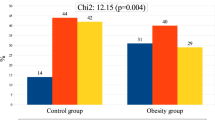Abstract
Objective: Improvement of vitamin D and K status of about 60 -y-old postmenopausal Dutch women.
Design: In a randomized study postmenopausal women with normal (T-score >−1; n=96) and low (T-score≤−1; n=45) bone mineral density (BMD) of the lumbar spine, were supplemented with 350–400 IU vitamin D3, 80 μg vitamins K1, vitamins K1+D3, or placebo for 1 y. Serum 25-hydroxyvitamin D [25(OH)D] and percentage carboxylated osteocalcin (%carbOC) were measured at baseline and after 3, 6 and 12 months.
Results: Baseline %carbOC of the entire study population was positively correlated with BMD of the lumbar spine and femoral neck. Correspondingly, women with low BMD had lower %carbOC at baseline than women with normal BMD but this difference disappeared after 1 y of supplementation with vitamin K1 ((mean±s.d.) 68±11% (95% CI, 64.5–71.2%) vs 72±6% (95% CI, 70.1–72.9%), respectively). One year of supplementation with vitamin D3 showed maximum increases in 25(OH)D of 33±29% (95% CI, 24.8–41.8%) and 68±58% (95% CI, 50.1–84.6%) in women with normal and low BMD, respectively. During winter, however, a 29% decline in maximum 25(OH)D levels was not prevented in women with low BMD.
Conclusion: Daily supplementation of Dutch postmenopausal women with >400 IU vitamin D3 is indicated to prevent a winter decline in 25(OH)D and to control serum parathyroid hormone levels. Daily supplementation with 80 μg vitamin K1 seems to be necessary to reach premenopausal %carbOC levels. A stimulatory effect of calcium and/or vitamin D on %carbOC cannot be excluded.
European Journal of Clinical Nutrition (2000) 54, 626–631.
This is a preview of subscription content, access via your institution
Access options
Subscribe to this journal
Receive 12 print issues and online access
$259.00 per year
only $21.58 per issue
Buy this article
- Purchase on Springer Link
- Instant access to full article PDF
Prices may be subject to local taxes which are calculated during checkout
Similar content being viewed by others
Author information
Authors and Affiliations
Contributions
Guarantors: A Schaafsma and FAJ Muskiet.
Contributors: AS was responsible for design, overall co-ordination, statistical calculations and writing of drafts and final manuscript. FAJ Muskiet advised in the field of clinical chemistry and actively participated in evaluation of the results of the study and final manuscript. HS was responsible for the chemical analyses as performed by the Medical Centre Leeuwarden. GH was responsible for the chemical analyses as performed by the University Hospital Groningen. IP was responsible for the medical evaluation of the women with a low bone mineral density. EvdV did the overall co-ordination of the project within the University Hospital of Groningen, and participated in the preparation of the drafts and final manuscript.
Corresponding author
Rights and permissions
About this article
Cite this article
Schaafsma, A., Muskiet, F., Storm, H. et al. Vitamin D3 and vitamin K1 supplementation of Dutch postmenopausal women with normal and low bone mineral densities: effects on serum 25-hydroxyvitamin D and carboxylated osteocalcin. Eur J Clin Nutr 54, 626–631 (2000). https://doi.org/10.1038/sj.ejcn.1601065
Received:
Revised:
Accepted:
Published:
Issue Date:
DOI: https://doi.org/10.1038/sj.ejcn.1601065
Keywords
This article is cited by
-
Changes in Parameters of Bone Metabolism in Postmenopausal Women Following a 12-Month Intervention Period Using Dairy Products Enriched with Calcium, Vitamin D, and Phylloquinone (Vitamin K1) or Menaquinone-7 (Vitamin K2): The Postmenopausal Health Study II
Calcified Tissue International (2012)
-
Possible site-specific effect of an intervention combining nutrition and lifestyle counselling with consumption of fortified dairy products on bone mass: the Postmenopausal Health Study II
Journal of Bone and Mineral Metabolism (2011)


